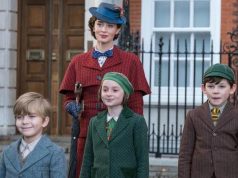Hey, kids! How would you like to see a new version of Disney’s “Sleeping Beauty” that isn’t animated and doesn’t make any sense? Hmm? You wouldn’t like that at all? Then why did we spend $200 million to make one?! You kids never appreciate anything.
“Maleficent” retells the Disney version of the classic fairy tale from the point of view of the villain, the horned witch-fairy who cursed baby Aurora to die via spinning wheel by the end of her 16th birthday. Now, you may be wondering: how can Maleficent be reformed into a sympathetic character without contradicting the story we already know? The answer is that she can’t. So “Maleficent,” written by studio stalwart Linda Woolverton (“Beauty and the Beast,” 2010’s “Alice in Wonderland”), changes the story to make the revisions work, and in the process loses everything that made it logical and coherent.
In this version, young Maleficent (played by Isobelle Molloy) is a happy fairy living among other fantastical creatures in the moors adjacent to a human kingdom. She befriends a boy named Stefan (Michael Higgins) and they fall in love; later, when they have grown up to be Angelina Jolie and Sharlto Copley, Stefan breaks her heart and cuts off her wings while she’s asleep, in a scene that is not at all uncomfortably rapey, nope.
Having thus explained why Maleficent hates King Stefan and might want to curse his baby, the film then proceeds to dismantle everything. The king sends baby Aurora to live in a cottage with three small, irritating pixies named Flittle (Lesley Manville), Knotgrass (Imelda Staunton), and Thistletwit (Juno Temple). In the original version, this was to hide the kid from Maleficent. In this version, Maleficent knows where they are, and in fact hangs around in the area and becomes Aurora’s playmate, somehow without the pixies’ knowledge.
Why Aurora is not allowed to know her true identity or that her three “aunts” have magic powers is not explained. Why she left the castle at all is not explained, in fact, if it wasn’t to keep her hidden from Maleficent.
Meanwhile, an increasingly insane King Stefan (portrayed with embarrassing hamminess by Copley) keeps sending his armies out to destroy Maleficent, but they can never find her, I guess because she’s always over at Aurora’s house.
Years later, when Maleficent has a change of heart about the whole curse thing, she finds it’s too late. The spell cannot be undone, even by her. That means the movie gets to have it both ways: Aurora (played as a teen by Elle Fanning) can still fall into her deep sleep, but now we don’t blame Maleficent for it. She tried to fix it! It’s all Fate’s fault now. Villain redeemed.
This shiny, lumpy mess of a movie, directed by first-timer Robert Stromberg, looks incredibly expensive yet feels like it was slapped together. It rushes quickly through its nonsensical plot, yet somehow seems drawn-out and overlong, too. Details clash. Maleficent can’t fly without wings, but she can work all sorts of other magic, including making other people fly. Despite her amazing powers, she incapacitates a guard by hitting him in the head with a club. We’re told at the beginning that the fairies and humans rarely enter one another’s jurisdictions, and then the entire film is full of disregard for that rule. And so on.
The three pixies, the handsome prince (Brenton Thwaites), and Maleficent’s raven-man companion (Sam Riley) are useless, none of them serving any purpose in the story. It really is all about Maleficent — who, it should be said, is brought to life vividly by the perfectly cast Angelina Jolie. It’s a nice touch that many of her lines in the christening/cursing scene are straight from the 1959 cartoon, but it’s a pity this new Maleficent doesn’t jibe with that one in any other respect.
C- (1 hr., 37 min.; )
Originally published at GeekNation.





